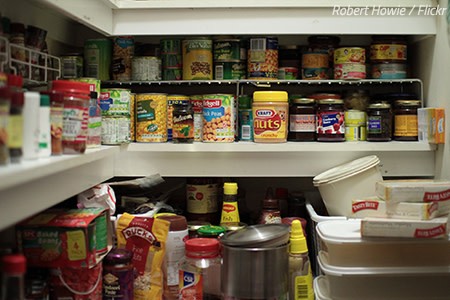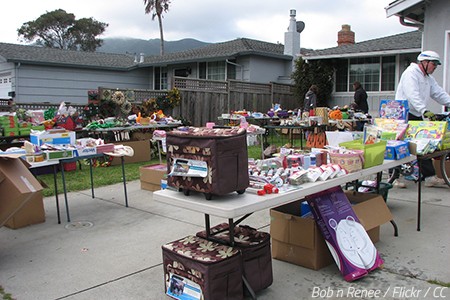 The period of moving from one home to another is filled with so many things to do and so many things to worry about that you shouldn’t be too surprised when you realize that you have failed to complete an important task, either because you just forgot about it or you just couldn’t find enough time to take care of it.
The period of moving from one home to another is filled with so many things to do and so many things to worry about that you shouldn’t be too surprised when you realize that you have failed to complete an important task, either because you just forgot about it or you just couldn’t find enough time to take care of it.
Of course, the best way to make sure you don’t forget to do something crucial when moving out is to follow a good Moving Checklist – the best time-management tool that will guide you from Day 1 of your preparation all the way until you step into the new home, and even a few days after the move is officially complete.
Now, one important task that may or may not be included in your moving timeline – depending on how detailed it really is – is to remind you to do something with all the food you currently have in the home. That’s right – that moving checklist entry is essential simply because it’s just wrong to throw away food that’s perfectly fine for consumption.
OK, so you shouldn’t waste food when moving out… but what should you do with it? Can you use it all up prior to the move-out date? Should you give it away to friends or neighbors? Or should you donate non-perishable food to charity?
Or maybe you just pack up all the food you’ve got and move it to the new home?
Read on to find out exactly what to do with food when moving.
Inspect the food supplies you currently have
One thing is clear – you need to decide what to do with all the food well before you move out so that you have enough time to actually do something with it. And here’s the very first problem you’re facing – you’re not exactly sure what types of food supplies you have left in the house.
So, now is the right time to inventory your food supplies. Go through all the places where you keep food in your home – fridge, freezer, kitchen cupboards, pantry, basement, etc. – and inventory all those food items in there using a pen and a notebook. To complete the food inventory faster, you can take quick photos of the areas where you store your food and then review those photographs one by one.
Sorting out your food supplies can be kind of fun, even – a good distraction from the endless task of packing your stuff for moving, box after box after box….
- Frozen food: meat, vegetables, ice cream, etc.
- Refrigerated foods: meat, eggs, seafood, milk, cheese, butter, juices, etc.
- Canned food: meat, vegetables, soups, etc.
- Boxed food items: chips, cereals, snacks, rice, beans, lentils, etc.
- Bottled food items: cooking oil, olive oil, dressings, etc.
- Cooking supplies: flour, sugar, spices, etc.
While inventorying the food supplies in your home before moving out, note down the quantity of each type of food item as well: moving one bottle of olive oil is acceptable, transporting 5 bottles of that stuff to the new home is not.
How to make a home inventory when moving
Throw away any food items that have expired
Time does fly by and before you know it, there’s a good chance that you’ll have a bunch of food items that are past their respective expiration dates. So, when you do happen to come across a food product that has expired, put it inside a separate cardboard box for the purpose of being discarded properly.
Do NOT consume any food items past their expiration dates, be it only with a few days. The risk is just not worth it – always bear in mind that your health and the health of the loved ones around you are your number one priority.

Are you really packing and moving all that food?
And, of course, you cannot donate any expired food items either, so the only way to get rid of those products is to recycle them in an environmentally friendly way: throw away all glass receptacles and cardboard containers in the proper recycle bins.
Now, once you’ve inspected all the food supplies in your home and got rid of all expired items, if any, it’s time for the next step: to decide what to do with your food before moving. Basically speaking, you’ve got several good choices:
- Use up,
- Give away or donate,
- Pack and move, or
- Recycle.
How to get rid of stuff before moving
Make a plan to use up your perishable food
What do you do with your perishable food when you move house?
You’ve already thrown away the food that nobody should consume anyway – hopefully, it’s only been a few long-forgotten products. Now it’s time to come up with a good plan for using up most or even all of the perishable foods you have in the home at the moment. The idea, of course, is to reduce food waste when moving house and to save up a bit of money in the process too.
So, how to use up your food before moving away?
- Limit your visits to the grocery store and purchase only food that you know you’ll be able to consume before you leave the house.
- Concentrate on using up the perishable food items that you have in the fridge or freezer, or in your pantry.
- Find the time to cook up any leftover food supplies instead of opting for the easiest ways – eating out or ordering in.
- Encourage all family members to come up with various ideas for tasty meals by looking at online recipes.
- Set aside enough food to prepare sandwiches or other delicious treats for Moving day and even for the first day in the new home.
The thing to remember when you’re getting ready to move out is that non-perishable food items – canned foods, boxed food items, and bottled food products that have never been opened – are much easier to give away and donate, so make sure you eat up the food in your fridge and freezer with priority.
See if your friends want any of your food items

Offer the food items you’re not moving to friends and neighbors.
Here’s the thing – you’re moving away and you won’t be taking all the food items found in your home. And you shouldn’t. More often than not, the money you’ll spend on transporting the food to the new home will be more, sometimes much more, than the cost of the food itself.
So, why should you bother packing and moving any food when it’ll be cheaper to just purchase brand-new food products once you arrive in the new town or city? Ask yourself this very question every time you feel uneasy about leaving your food behind, and remember – you’re not throwing away good food, you’re just giving it away to somebody who will use it. And that’s the right thing to do too.
Ask your friends if anyone is interested in taking any of the food items you’ve decided not to move to the new house. You have the perfect excuse too – you’re moving away and you can’t take that food with you. The moving away party may be the best timing for it – just show your pals the piles of non-perishable foods you’re leaving behind and tell them to help themselves.
You can also go to your favorite neighbors and see if they would like to have some of your food supplies as well. After all, your goal is to not let perfectly good food go to waste simply because you’re moving away.
How to say goodbye to friends when you move
Consider donating your non-perishable food
If you’re still left with non-perishable food as Moving day looms on the horizon, the best thing you can do about those unopened non-perishables is to donate them to local families that need them more than you do.
Move for Hunger – a non-profit organization that collects non-perishable food and delivers it to different food banks all over North America – states that each month the average American family throws away more than 23 pounds of food per person.
Without a doubt, you should always consider donating your food when you move – a nice gesture of goodwill toward less fortunate families. It’s a win-win situation, really – you’re doing something nice for the community and you’re saving money from having to transport all that non-perishable food to the new home.
How to donate food when moving? Ultimately, you have a couple of good options here:
- TAKE your non-perishables to a nearby food bank, or
- ASK your movers if they are part of the Move for Hunger program. If yes, then they will take the non-perishable food items you’ve decided to donate and will take them to a food bank without an extra charge.
When you donate food before moving out, you’re also doing your part in minimizing food waste. Just make sure that all the food products are still unopened and have not been expired.
10 Ways to stay organized when you move
Pack up the food items you want to keep
Hopefully, you’ll have listened to our advice to use up all the perishable food items you have in the house and then discard most of the non-perishable food products by giving them away, donating them, or recycling them properly.
Now it’s finally time to pack the food you wish to take with you to the new place. Here’s how to pack food for moving:
-

Clear plastic bins are for holding your food products on the road.
Canned foods. Canned food items are rather heavy, so make sure you are moving only the ones that are expensive or unique in any way. Pack them up in small cardboard boxes due to their substantial collective weight. Ultimately, the best moving containers for canned food products are plastic storage bins that won’t break under the extra weight.
- Dry food products. If you’re moving packets or boxes of already opened dry goods such as rice, pasta, flour, sugar, etc., then be sure to tape up their openings, place them in re-sealable plastic Ziploc bags and pack them into small to medium moving boxes. Of course, you can use regular plastic bags too – such as clean trash bags – the idea is to prevent any spills during the move itself.
- Glass containers. Wrap all glass bottles or jars in several sheets of soft packing paper, tape the paper bundles, and transfer them into moving boxes made of thick cardboard (dish packs). Use pieces of paper to fill in any holes inside the boxes to prevent the glass containers from shifting in the cartons.
Bear in mind that you should pack as few food products as possible. Why? Oftentimes, the money you’ll pay to transport all that food items to the new place will be more than to actually replace them after the move.
Also, don’t bother packing and moving frozen food or refrigerated food as they fall into the no-no category of items that are not allowed for transport due to safety concerns. Nevertheless, if you must move any frozen or refrigerated foods, then make sure you transport them in coolers.
What to Pack When Moving: Packing Checklist
The post What to Do With Your Food When Moving: Don’t Waste Food appeared first on The Moving Blog.







